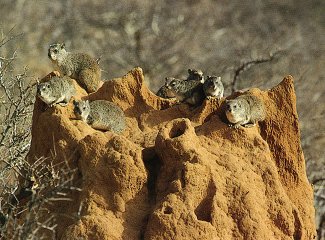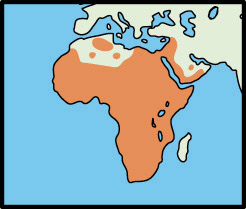THE ORDER HYRACOIDEA
Table of Contents
Hyracoidea – Hyrax-Like Mammals (11 species)
The hyrax, or dassie, is an odd mammal that superficially resembles a guinea pig and is about the size of a rabbit. It is neither, however, but is more closely related to elephants, manatees, and the aardvark. They can be traced through fossils to the Eocene epoch about 50,000,000 years ago.

Hyraxes are found in Africa and along the Red Sea on the Arabian peninsula. They live in all types of habitats, as seen in the names of the Tree Hyrax and the Rock Hyrax. There are five species that make up the order Hyracoidea, although other biologists assume four species. Stay tuned for further announcements. But to live in these different environments the Hyrax has developed glands in the soles of their feet that secret a substance allowing them to maintain a firm grip in the rocks and trees where they live much like the traction suction cups provide.
Hyraxes have a short, rather blunt head, small ears, and a pair of widely separated, protruding and pointed upper incisors which grow continuously from the base. In lieu of canine teeth is a wide gap, similar to that in rodents and lagomorphs.
Hyraxes live in colonies of from five up to eighty individuals and are herbivorous in their diet. They live to about ten years of age but have been known to top fourteen years of age. They usually live in rock crevices but are not averse to inhabit the burrows of other animals. They have an unusually large vocal range, with grunts, howls, and squeaks that confound and startle newcomers to Africa’s wildlife.
Check out the Rock and Tree Hyraxes.
Cape, or large-toothed rock, hyrax
PROC AVIA CAPENSIS
- Class: Animals with Milk Glands (Mammalia)
- Subclass: True Mammals (Eutheria)
- Order: Hyrax-like Mammals (Hyracoidea)
- Family: Procaviidae.
The Name “Hyrax”: “Hyrax” comes from the Greek “hurax,” meaning shrew mouse.
 Location: Africa South of the Sahara, Arabia, and the Middle East.
Location: Africa South of the Sahara, Arabia, and the Middle East.
Habitat: Terrestrial, on rocky terrain in savanna and semiarid regions.
Description: They are usually brownish-gray on the back and cream underneath, although some hyraxes are yellowish in color. The coat is dense with thick underfur, but on the back, there is a hairless area corresponding to the position of a dorsal gland which produces the characteristic odor of the species. The gland is surrounded by longer, erectile hairs which are yellow, orange, brown, or black. The upper incisors are triangular in cross-section and evergrowing, like the rodents. They are about 12 to 22″ long, with a short tail about 1/2 in, and they weigh up to 9.5 lbs.
Behavior: This is the only species of hyrax found outside of Africa. They live in colonies, unlike the tree hyraxes. These colonies are composed of family units that may number more than fifty individuals, which usually remain close to rocky crevices where they can duck out of sight when danger looms. They are diurnal and spend much time sunning themselves. They are vegetarian and may forage as far as half-a-football-field away from the safety of the rocks in search of food. They need very little water to survive.
Reproduction: Gestation lasts six or seven months when the female gives birth to two to four young, whose eyes are open and who have fully developed coats of fur. They are able to eat solid food after only a few days and are completely weaned by ten weeks.
Beecroft’s tree hyrax – DENDROHYRAX DORSALIS
The Name “Hyrax”: “Hyrax” comes from the Greek “hurax,” meaning shrew mouse.
- Class: Animals with Milk Glands (Mammalia)
- Subclass: True Mammals (Eutheria)
- Order: Hyrax-like Mammals (Hyracoidea)
- Family: Procaviidae.

Location: West and Central Africa.
Habitat: Arboreal. Tropical forest.
Description: The fur is short but dense, and the nose is hairless. On the back, there is a yellowish patch of fur surrounding the dorsal gland. The soles of the feet are black and have numerous ridges for gripping tree branches. The front feet have 4 toes, but the hind feet have only three. Their body length is 17 to 24 in, with a short tail adding about 1/2 to 1 1/4 in. They weigh about 4 to 10 lbs.
Behavior: This hyrax is a herbivorous and arboreal animal, which spends the daytime in tree hollows. It leaves the trees during the night to forage. It is normally a solitary animal, but small groups of two or three individuals are not unusual. The main predators of this hyrax are leopards, genets, pythons, and birds of prey, but it is also hunted by man for food and for its dense pelts.
Reproduction: Gestation lasts for about eight months, with the young born in March and April in Gabon and the Cameroons, and in May through August in Zaire. In most cases just one young is born, although two may appear on rare occasions.
Note: The hyraxes have molar teeth that look like miniature rhinoceros teeth, with large, persistently-growing, upper incisors, and hooplike nails on most toes, as well as many other anatomical details that are distinctive. Immunological data suggest that these hyraxes are most closely related to aardvarks, elephants, and the sirenians.
